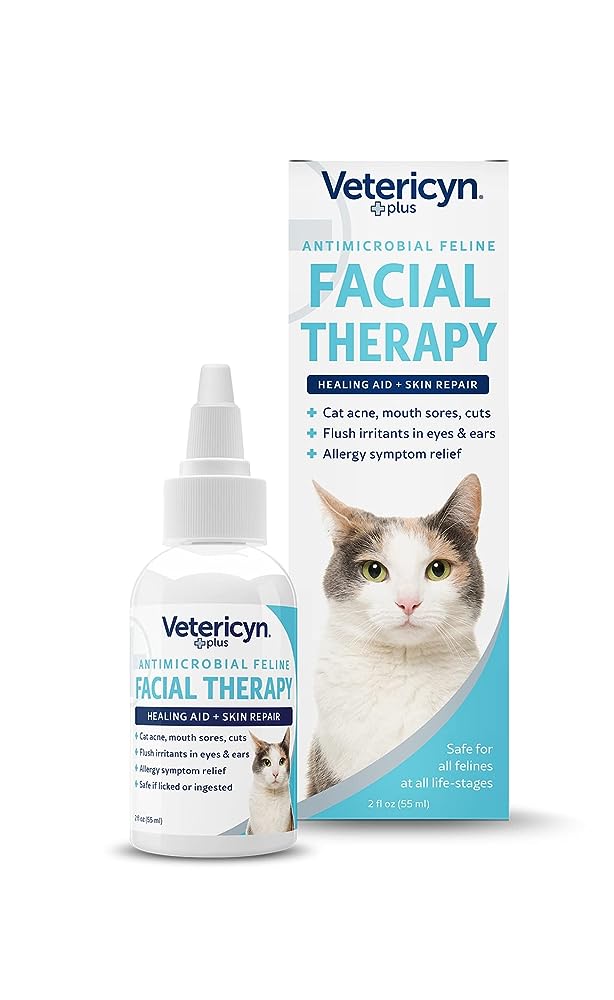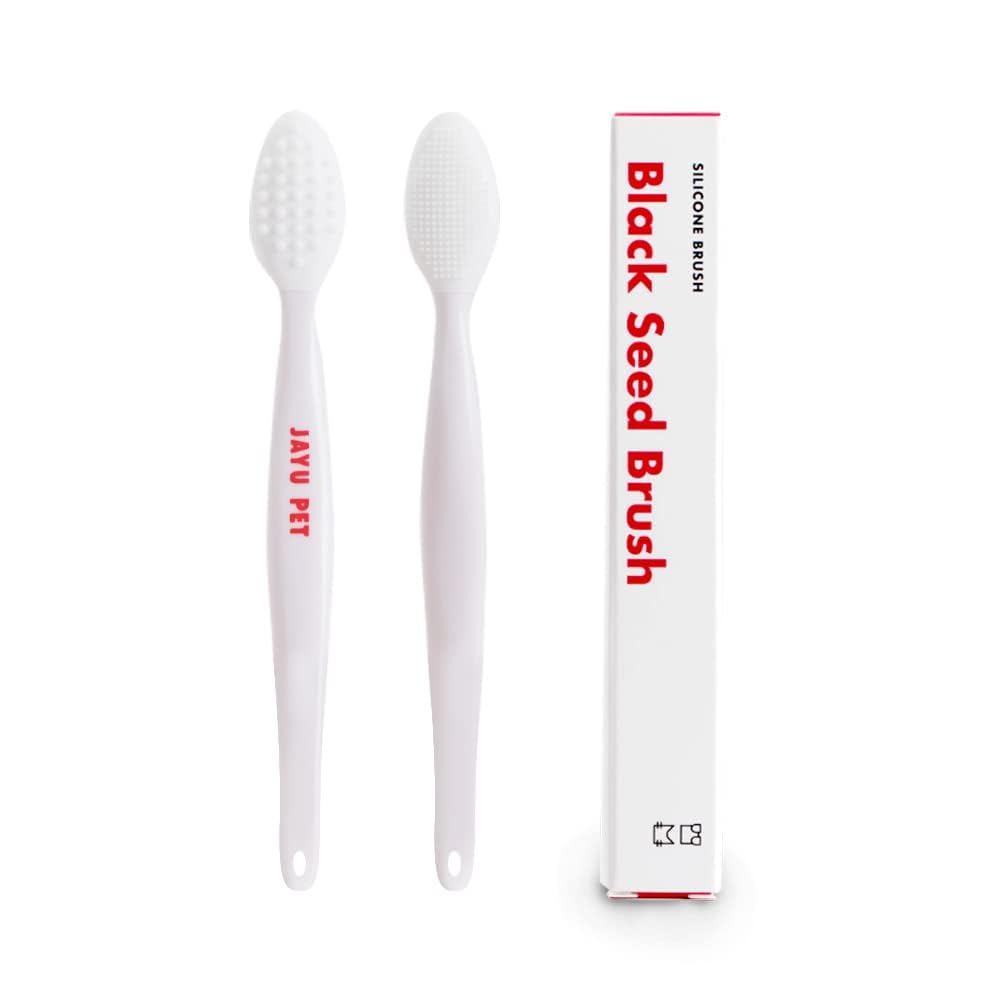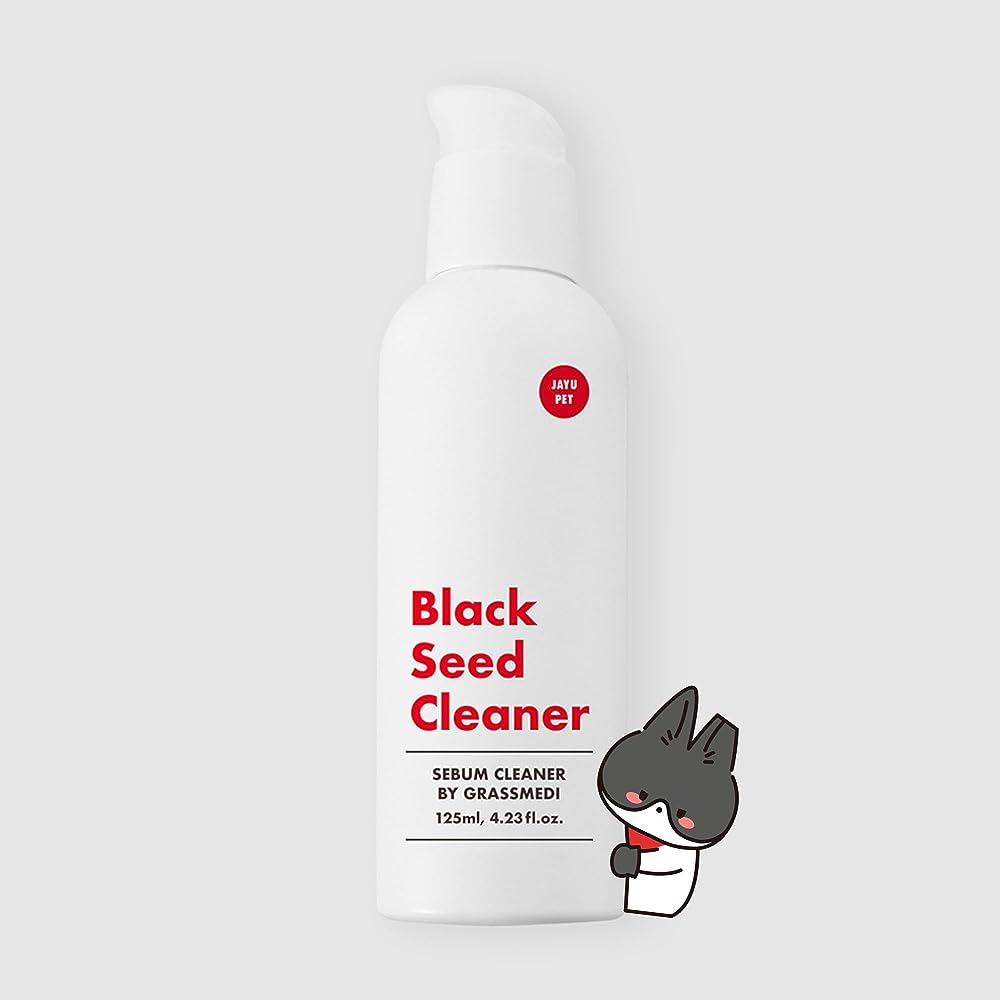iHeartCats is reader-supported. When you buy via links on our site, we may earn an affiliate commission at no extra cost to you.
Just as humans can be plagued by the nuisance of acne, our feline companions too, at times, suffer from this skin ailment. Though not life-threatening, cat acne can be uncomfortable for your pet and may even become a source of concern if left untreated. Diving into the world of cat acne treatments, this article sheds light on the top remedies and preventative measures, ensuring your kitty maintains the flawless fur and healthy skin it deserves.
#1 – Vetericyn Plus Feline Facial Therapy | Healing Aid and Skin Repair for Different Cat First Aid Needs, Including Cat Acne, Cat Ear and Eye Problems. 2 ounces
The Vetericyn Plus Feline Facial Therapy is a healing aid and skin repair product designed specifically for cats. It is used to treat various cat first aid needs, including cat acne, cat ear and eye problems. It helps to kickstart the healing process for common ailments such as chin acne, mouth sores, and cuts. Additionally, it can be used as a cat ear cleaner or cat eye drops for daily care. This non-toxic solution is safe to use on cats at all life stages and is made in the USA by Vetericyn, a trusted company in at-home animal health products.
Best For: Cat first aid needs including cat acne, ear and eye problems.
#2 – JAYU PET Black Seed Brush – Cat Acne Chin Treatment, Cat Acne Brush, Silicone Brush for Cats Chin Acne & Blackhead Exfoliation, Double-sided Cat Grooming Brush (1PCS)
The JAYU PET Black Seed Brush is a silicone brush designed for treating cat acne and blackheads on the chin. It has a double-sided design, with one side for deep cleaning and the other for gentle massage. The brush is reusable and made from premium plastic, with a soft silicone brush head that is non-irritating to cats’ skin.
Best For: Treating cat acne and blackheads on the chin.
#3 – JAYU PET Black Seed Cleaner – Cat Acne Chin Treatment | Feline Acne Chin Remover Solution | Cat Hot Spot Relief | Non-Toxic Kitten Sebum, Blackhead Soothing Care 4.2fl.oz (125ml)
The JAYU PET Black Seed Cleaner is a cat acne chin treatment and feline acne chin remover solution that helps manage common feline skin troubles such as blackheads, acne, hotspots, and over-sebum around the chin, nose, mouth, and tail. It is made without steroids or harmful components and has received a safe grooming rating from the Environmental Working Group. Developed by veterinarians, medical doctors, and Oriental medical doctors, this cleaner is formulated with patented ingredients and a vet-approved formula that is effective in removing pet sebum while being gentle on the skin.
Best For: Treating cat acne and feline skin troubles.
#4 – Mooncat Kitten & Cat Acne Chin Treatment | First Cuztomized Cat Acne Cleanse Lotion | Pionner in Cat Care Stuff | Concentrated Solution For Cat Chin & Tail | Prevention for Cats Acne -5 fl oz(150ml)
The Mooncat Kitten & Cat Acne Chin Treatment is a concentrated lotion designed to prevent and treat cat acne, specifically on the chin and tail. It is suitable for all cat breeds and ages, and uses vet-grade ingredients such as jojoba seed oil, vitamin E, and aloe vera to moisturize and protect the cat’s skin. It helps to balance oil secretion and soothe sensitive skin, reducing the likelihood of acne outbreaks.
Best For: Prevention for Cats Acne
#5 – Breezytail PetO’Cera CICA Toner – Cat Acne Treatment | Cat Hot Spot Relief| Cat Blackhead Solution| Cat Soothing Toner | No Harsh Ingredients | Hypoallergenic Skin & Coat Care for Cats | 7.1 oz
The Breezytail PetO’Cera CICA Toner is a toner specifically designed for cats to treat acne and itchy skin. It provides moisturization for dry skin and is formulated with veterinarian professionals to be extra mild yet effective. The product is made with safe ingredients and discloses all the ingredients used, without any hidden chemicals or harmful substances.
Best For: Cat acne treatment and soothing sensitive skin.
#6 – Breezytail PetO’Cera CICA Toner – Cat Acne Treatment | Cat Hot Spot Relief| Cat Blackhead Solution| Cat Soothing Toner | No Harsh Ingredients | Hypoallergenic Skin & Coat Care for Cats | 7.1 oz
The Breezytail PetO’Cera CICA Toner is a cat acne treatment and skin-soothing toner that is specifically formulated for cats. Made with safe and hypoallergenic ingredients, this toner helps to moisturize and relieve dry and itchy skin in cats. It has been developed in collaboration with veterinarians to ensure it is gentle and effective for your pet’s sensitive skin.
Best for: Hypoallergenic skin and coat care for cats.
What Should I Consider When Purchasing a Cat Acne Treatment Product?
When purchasing a cat acne treatment product, several important factors should be kept in mind:
- Ingredients: Review the active and inactive ingredients. Natural and hypoallergenic ingredients are preferable as they are less likely to cause allergic reactions or further irritation. Avoid products with harsh chemicals or excessive fragrances.
- Veterinarian Recommendation: It’s always a good idea to consult with your veterinarian before introducing any new treatment to ensure it’s suitable for your cat’s specific condition and won’t interfere with other medications or treatments they might be receiving.
- Type of Treatment: Cat acne treatments come in various forms such as wipes, creams, lotions, and shampoos. Consider which form would be most effective and convenient for both you and your cat.
- Safety: Ensure the product is specifically designed for cats. Some products made for dogs or humans can be harmful or toxic to cats.
- Brand Reputation: Choose a reputable brand, preferably one that specializes in pet care or cat health. Checking reviews and ratings can help determine the product’s effectiveness and reliability.
- Ease of Application: Consider how easy the product is to apply, especially if your cat is skittish or doesn’t like to be handled much. For instance, wipes might be more convenient than creams for some cats.
- Price and Quantity: While price shouldn’t be the only determining factor, it’s worth considering how much product you’re getting for the cost. A more expensive product might be more cost-effective in the long run if it’s more concentrated or effective.
- Possible Side Effects: As with any product, there’s a potential for side effects. Read the label carefully and monitor your cat’s reaction to the treatment.
- Purpose: Some treatments target the symptoms of cat acne (like inflammation or itchiness), while others might target the root cause. It’s essential to know what you’re aiming to treat.
- Frequency of Application: Consider how often the product needs to be applied and ensure it aligns with what’s feasible for your routine.
Remember, while treating cat acne, maintaining a clean environment, especially around their chin and food bowls, is crucial. It’s also essential to monitor the acne’s progress and consult a veterinarian if it worsens or doesn’t improve after consistent treatment.
What Are Some Ways to Prevent Cat Acne?
Certainly! Cat acne, primarily found on the chin and lower lip, can be unsightly and uncomfortable for your feline friend. Here are some effective ways to prevent cat acne:
- Regular Cleaning: Gently cleanse your cat’s chin regularly using a soft cloth dampened with warm water. For a more thorough clean, consider using cat-specific facial wipes or antiseptic solutions recommended by veterinarians.
- Stainless Steel or Ceramic Bowls: Plastic food and water dishes can harbor bacteria and cause a reaction in some cats. Switching to stainless steel or ceramic bowls can help reduce the risk of acne development.
- Clean Bowls Frequently: Whatever type of bowl you use, ensure they’re washed regularly to prevent bacterial buildup. Leftover food particles and saliva can contribute to acne formation.
- Avoid Plastic Toys and Feeders: Just like with plastic bowls, other plastic items can harbor bacteria. If your cat frequently rubs against or plays with plastic toys, consider replacing them with items made of different materials.
- Balanced Diet: A well-balanced diet plays a crucial role in overall skin health. Ensure your cat is receiving high-quality, nutritious food. Some cats may benefit from supplements like omega fatty acids that promote skin and coat health.
- Regular Vet Check-ups: Routine check-ups allow your veterinarian to catch early signs of acne or other skin issues, offering preventive advice or treatments as needed.
- Reduce Stress: Stress can be a contributing factor to various health issues, including skin problems. Ensure your cat has a stress-free environment by providing them with a comfortable resting space, toys, and regular interaction.
- Limit Use of Topical Products: Only use topical products that are specifically designed for cats. If using flea treatments or other topical products, ensure they don’t irritate the skin and possibly lead to acne.
- Regular Grooming: Especially for long-haired cats, regular grooming can help keep the chin area clean and free from irritants.
- Avoid Over-Cleaning: While keeping the chin clean is essential, over-cleaning or using harsh products can irritate the skin, leading to more breakouts. Always be gentle and use cat-specific or vet-recommended products.
By maintaining a clean environment, monitoring your cat’s skin health, and following these preventive measures, you can significantly reduce the risk of cat acne. If acne does occur, consult with your veterinarian for proper treatment and care recommendations.
Frequently Asked Questions About Cat Acne Treatments
- What is cat acne? Cat acne is a skin condition where blackheads or pimples form on a cat’s chin and lower lip. It’s similar to human acne and is usually caused by blocked hair follicles.
- What causes cat acne? Cat acne can be caused by a variety of factors, including hormonal imbalances, stress, poor grooming habits, reactions to certain materials like plastic, or bacterial infections.
- Is cat acne contagious? No, cat acne is not contagious to other cats or humans. It is a condition specific to the individual cat’s skin health.
- How is cat acne treated? Treatment can include topical antiseptics, antibiotics for bacterial infections, regular cleaning of the affected area, and sometimes, vet-prescribed medicated shampoos or ointments.
- Can I use human acne treatments on my cat? No, you should never use human acne treatments on cats as some ingredients might be toxic or too harsh for feline skin. Always consult your vet before applying any product.
- How can I prevent my cat from getting acne? Preventative measures include using ceramic or stainless steel bowls, cleaning the bowls regularly, maintaining proper grooming habits, and ensuring your cat eats a balanced diet.
- Is cat acne a sign of other underlying issues? While cat acne is typically a standalone issue, it can occasionally be indicative of other underlying health conditions or hormonal imbalances. Always consult with your vet if you notice recurrent breakouts.
- Do over-the-counter cat acne treatments work? Some over-the-counter treatments can help with mild cases, but it’s essential to choose products specifically designed for cats. For severe or persistent cases, consult your veterinarian.
- My cat’s acne isn’t going away. What should I do? If your cat’s acne persists or seems to worsen, it’s essential to see a veterinarian. Persistent acne can lead to more severe skin infections or be a sign of other health issues.
- Are certain breeds more prone to acne? Cat acne can affect any breed, but some believe that flat-faced breeds like Persians may be more prone due to their facial structure. However, individual susceptibility varies, and all cat owners should be vigilant about their pet’s skin health.
Conclusion: Best Cat Acne Treatments
Addressing and treating cat acne promptly can prevent complications and keep your feline friend feeling their best. With a variety of treatments available, it’s important to select the one best suited to your cat’s individual needs. By understanding the underlying causes and committing to regular skin and fur maintenance, you can ensure your cat remains acne-free and thrives with the radiant glow of health. Always consult with a veterinarian before starting any treatment to provide your feline with the best care possible.







